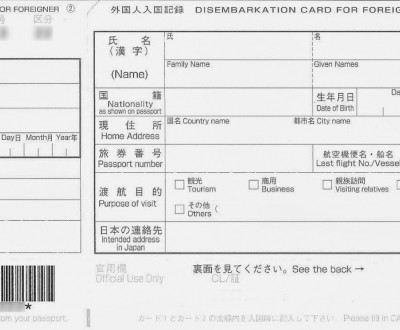The Japanese Disembarkation Card for Foreigners
About one hour before landing in Japan, the cabin crew hands out small cards to passengers. These bilingual Japanese and English documents are called the Japanese Disembarkation Card for Foreigners and the Customs 🛂 Declaration. Filling them in is compulsory before going through Japanese immigration and customs services.
After 10 hours or more of flight in a pressurized atmosphere, the traveler’s mind might not be as sharp as usual, and the cabin crew might not be able to help as they are busy in preparation for landing. Japanese immigration and custom agents are very strict with any crossing-out or inaccuracy, so it is very important to carefully fill in the cards. This is the key to a smooth and swift arrival in Japan.
Disclaimer – The content provided on this webpage is for information purposes only. Filling in the Japan Disembarkation Card for Foreigners and the Customs Declaration forms is the sole responsibility of each traveler and Kanpai cannot be held liable for any mistake or inconvenience.
The Disembarkation Card
The Japanese Disembarkation Card for Foreigners (外国人入国記録 gaikokujin nyûkoku kiroku) is a recto-verso form. It will be collected by the immigration services, whose officer will also put a stamp on your passport.
The card’s purpose is for you to provide information about your identity and your stay in Japan.
One of the most frequent questions is which intended address in Japan and telephone 📱 number to provide. As travelers may have booked several accommodations to fit their journey, they might be puzzled about how to answer. You only need to write down the address and telephone number of the first hotel 🏨 or apartment of your stay (make sure to have the information printed or readily accessible before your departure). For other travelers, it might be best to write down the address and telephone number of the place where they will stay the longest, even if it is not the first accommodation.
The back side of the card is also to be filled in carefully. You might undergo a thorough cross-examination in the following cases:
- if you answer "yes" to any of the three first questions
- and/or if you declare travelling with more than one million yen (~US$6,388) in cash per person
The Japanese Immigration Services Agency recently started the Trusted Traveler Program. This program allows, under certain conditions, expedited customs formalities for frequent visitors who can go through automatic gates.
However, this service is only accessible upon prior registration and is submitted to authorization upon the first entry in Japan.
The Japanese Immigrations Services Agency has provided information about this service on their Offical Website (in English).
Visit Japan Web since late 2022
With the resuming of post-Covid 🦠 tourism, it is highly recommended to register on the Japanese governmental site "Visit Japan Web" before departing to Japan, to speed up the procedures upon arrival.
Further explanations are available in a dedicated post:
The Customs Declaration
This second document is to be submitted to customs officers once you have retrieved your checked baggage.
The customs officer can decide whether or not to inspect your luggage and/or bags, even if what you have declared stays within the authorized limits.
Since August 2019, the Electronic Customs Declaration Gate System, or e-Gate, has been introduced at Narita Airport Terminal 3. The system is to be extended to Narita Airport Terminals 1 and 2, Haneda, Kansai, Chubu, Fukuoka, and New Chitose airports by spring 🌸 2020.
To use the e-Gate system, the traveler must download the Customs Declaration App (only available in Japanese at the moment) and fill in the electronic form. A QR code will then be generated with the information of the declaration. This QR code and the IC passport must be scanned at the terminal. During the process, a face picture will also be taken. The traveler can then pick up their checked baggage and exit the airport.
An explanatory comic strip is displayed on the Japanese Customs website to help travelers understanding the procedure.
In compliance with the duty free, each adult should not carry more than:
- 3 bottles of alcohol (of 75 ml each)
- 100 cigars or 400 cigarettes or 500 g of tobacco (note that in 2021, from October 1st, the allowance will be changed to 200 cigarettes, 50 cigars, or 250 g of tobacco)
- 60 ml of perfume (2 ounces)
- And objects of less than ¥200,000 (~US$1,278) global value, not including objects of less than ¥10,000 (~US$63.88) global value each.
However, if you carry more than what is allowed, the customs duties are still affordable. As an example : ¥500 (~US$3.19) per liter for rum, or ¥13 (~US$0.08) per cigarette.
It is strictly forbidden to import the following items in Japan:
- All kinds of drugs (even soft drugs)
- Firearms, ammunitions, explosives, chemical weapons
- Counterfeit products and means of payment
- All kinds of pornography
Be careful to strictly follow this list as any infringement can be severely punished.
Please note that there might be some importation restrictions on items such as:
- plants
- living animals
- food and beverages
- pharmaceutical and cosmetic products
General Rules
Always write in capital letters.
Be honest: always fill in the forms with the most sincere information as the Japanese Immigration Services and Customs officers might ask for additional details.
Crossing-out or alterations are not allowed. The cabin crew can usually provide extra blank documents in the plane ✈️. Otherwise, these documents are easily available in the waiting room for immigration, before entering Japan.
Write down all your firstnames, even if you do not use them all. The informations filled in the forms must be exactly the same as they appear on your passport.
In the gallery, you will find samples of a Japanese Disembarkation Card for Foreigners and of a Customs Declaration form to help you fill in these documents.


